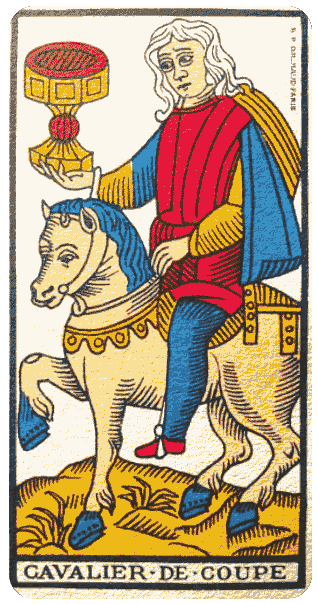synthetic meaning
The Knight of Cups, hatless, supporting on his right hand a large open cup and trotting to the left, indicates the enthusiastic impulse of beings called to that which is Above and carried towards altruistic growth.
analytic meaning
The Knight of Cups signifies a pledge in exchange for an offering; the Knight is coming with this pledge, one of an animistic order, first by virtue of the innate significance of the Cup and then because he is turned towards the left.
specific analogies
This Knight has the appearance of a mounted Page. The Cup, which he holds positioned on the palm of his right hand just like that of the Page of Cups, symbolizes accumulated earthly treasures, that is to say, all human knowledge, but these treasures, which motivate the bearer of the Cup, are transitory, such knowledge not being able to be crystalized in a state of immobility.
While the Cup has the shape of a hourglass, it is able to be inverted and the knowledge which it contains in a passive state can become unconscious; it is also able to be oriented towards that which is Above as well as below and to be good as well as bad; the Knight's Cup violates this symmetry; it is mostly uncovered to show that the treasures of knowledge in its possession are no longer able to change their qualities; they are good or evil.
His head, without a hat, and the open cup are indications that he is receiving inspiration and apport directly from Above.
The horse, flesh colored, symbolizes the nervous energy and the vital forces expended for the things imported into it; the trotting of the horse expresses impulse and shows that these forces could overtake the power of the Knight if he does not keep it restrained with a mere pair of reigns held in his left hand, indicating therefore that he is not wholly able to direct it, but only restrain it.
The red sphere at the center of the cup has the same significance as that of the Page of Cups, the effort which the soul must exert in the material world.
The blue mane as well as the four hooves have the same meaning as they do for the Knight of Swords.
The four points on the collar of the house answer to the quaternary and to Lame IV, the Emperor, and indicate the powerful force of the apportand his solidity; the four points and the three points on the rump straps show that the Knight operates on the three planes of consciousness and under the four constituent aspects of the material plane, which is to say, with a great expanse (3+4=7=the range).
The yellow ornaments which decorate the horse show that intelligence is at the foundation of his action, and the white stirrup shows that the Knight's fulcrum is neutral: we do not hold onto knowledge: it departs, it spreads out.
The variety of colors on his clothing has the same meaning as it does for the Knight of Batons.
Same meaning for the ground as for the Knight of Swords.
meanings as they relate to the three planes
MENTAL. The contribution of fertile ideas, inspiration, ideas which spontaneously emerge.
ANIMISTIC. Flowering of artistic gifts, especially for a musician, since the scale is represented by 4 + 3 = 7.
PHYSICAL. Happy marriages, good matches, very good health.
INVERTED. The power of the Card is halved, being too active to be eliminated; there is delay or embarrassment.
In its Elementary Sense, the Knight of Cups represents the sensible and affective part of Man, susceptible to great enthusiasm and devotion.
@nifo@innergarden.org
Inner Garden Foundation
P.O. Box 8520, 3542AD
Utrecht, The Netherlands
